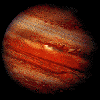 Jupiter Jupiter
It's the biggest planet in our solar system almost big enough to be a star in its own right. Jupiter was explored in flybys in the 1970s by NASA's Pioneer 10 and 11 and spacecraft, and is currently being studied by the Jupiter-orbiting spacecraft.
Jupiter is a giant ball of gas; like the Sun, it is made up mostly of hydrogen and helium. There's no solid surface as such, and its swirling atmosphere features many colorful, intriguing features. One big mystery is the Great Red Spot--a storm almost the size of three Earths that has raged across the planet for more than 300 years.
Planet Profile
Mass (kg)............................................1.90 x 10^27
Diameter (km)........................................142,800
Mean density (kg/m^3) ...............................1314
Escape velocity (m/sec)..............................59500
Average distance from Sun (AU).......................5.203
Rotation period (length of day in Earth hours).......9.8
Revolution period (length of year in Earth years)....11.86
Obliquity (tilt of axis in degrees)..................3.08
Orbit inclination (degrees)..........................1.3
Orbit eccentricity (deviation from circular).........0.048
Mean surface temperature (K).........................120 (cloud tops)
Visual geometric (reflectivity)...............0.44
Atmospheric components...............................90% hydrogen,
10% helium,
.07% methane
Rings................................................Faint ring.
Infrared spectra imply dark rock fragments.
|
 Jupiter
Jupiter